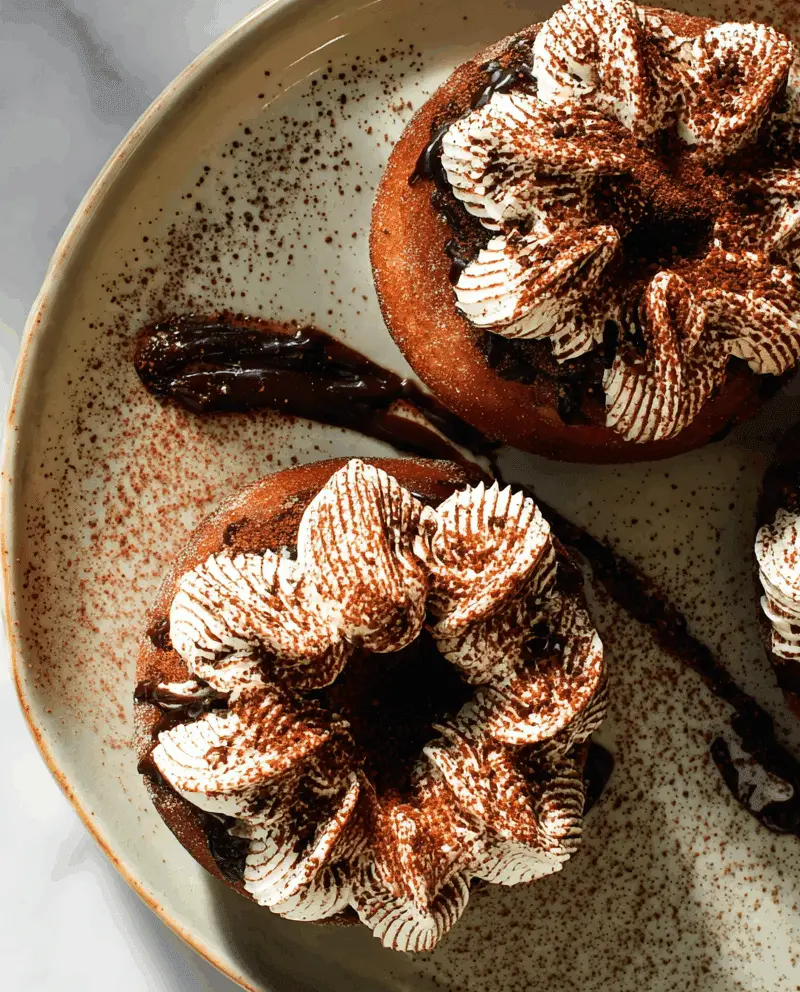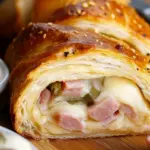Take your love for tiramisu to the next level with these Carnival‑Style Tiramisu Doughnuts—a dreamy fusion of airy, golden-fried dough and silky mascarpone‑espresso cream. Perfectly proofed overnight, each bite bursts with flavor and tradition, dusted with cocoa for that classic tiramisu touch.
Ideal for festive mornings or dessert tables, these doughnuts bring elegance and fun together. Whether you’re indulging after breakfast or serving guests, they’ll be the star of the show.
Full Recipe
Ingredients:
-
Dough (yields ~14 doughnuts)
-
560 g all‑purpose flour
-
40 g granulated sugar
-
120 ml warm water
-
60 ml warm milk
-
3 tsp active dry yeast
-
3 large eggs
-
1 tsp lemon zest
-
1 tbsp rum (optional)
-
8 g salt
-
100 g unsalted butter, softened
-
-
Tiramisu Cream
-
4 egg yolks
-
80 g sugar
-
3 tbsp all‑purpose flour
-
1 tsp vanilla paste
-
250 ml milk
-
2 tbsp cold butter
-
500 g mascarpone
-
1 tsp orange zest
-
Pinch of salt
-
2 tbsp fresh orange juice
-
-
Decoration & Filling
-
150 ml freshly brewed espresso
-
2 tbsp unsweetened cocoa powder + 1 tbsp powdered sugar
-
Directions:
-
Make dough: In a mixer bowl combine flour, sugar. Add warm milk/water, yeast, then eggs, lemon zest, rum, salt. Knead 6–8 min until elastic, then add butter and knead another 3–4 min.
-
Proof: Cover bowl and let rise 2 hrs at room temp, then refrigerate overnight (12–16 hrs).
-
Shape & proof again: Divide into 14 balls (~65 g each), place on parchment squares on a baking tray, cover and let rise 1½–2½ hrs until tripled.
-
Fry: Heat 170–180 °C oil in a heavy pan. Fry doughnuts covered 2–3 min each side, then uncovered 2–3 min more. Drain on paper towels.
-
Pastry cream: Whisk egg yolks, sugar, flour, vanilla. Pour in boiling milk, cook until thick. Chill with ice bath, whisk in cold butter.
-
Tiramisu cream: Combine pastry cream with mascarpone, orange zest, salt, and juice. Beat until smooth.
-
Assemble: Poke hole in each cooled doughnut, add a tsp espresso, then pipe in tiramisu cream.
-
Finish: Dust generously with blended cocoa powder and powdered sugar.
Prep Time: 45 minutes (plus overnight proofing) | Cooking Time: 15 minutes | Total Time: ~1 hr 45 min (+ proofing)
Kcal: ~350 kcal per doughnut | Servings: 14 doughnuts
An Irresistible Fusion of Two Beloved Desserts
The Tiramisu Doughnut is more than just a recipe—it’s a beautiful culinary hybrid that merges the best elements of Italian elegance with the cozy decadence of deep-fried pastries. At its core, it’s a celebration of textures, flavors, and the universal love for indulgence. Inspired by the traditional Italian tiramisu, this doughnut layers creamy mascarpone with bold espresso, all housed within a pillowy, golden-brown doughnut shell. If you love tiramisu and can’t resist doughnuts, this recipe is destined to become your new obsession.
What makes this treat stand out is not just its flavor profile, but its careful attention to preparation. From the slow fermentation of the dough to the delicate balance of orange zest in the mascarpone cream, every element is designed to elevate the final bite. It’s a doughnut that feels both luxurious and nostalgic—perfect for special occasions, holiday brunches, or when you simply need to treat yourself.
Cultural Origins and Inspirations
Tiramisu itself is an Italian dessert with disputed regional origins, often associated with the Veneto or Friuli Venezia Giulia regions. Its name translates to “pick me up,” a nod to its energizing espresso content and uplifting sweetness. Traditionally served in layers in a dish, tiramisu typically includes ladyfingers soaked in coffee, a mascarpone-based cream, and a generous dusting of cocoa powder.
In this doughnut version, the dish takes on new life while honoring its roots. The idea to turn tiramisu into a filled doughnut reflects the growing trend in modern pastry making to reinterpret classics in innovative, fun formats. It’s the perfect example of how food cultures can merge and inspire something entirely new, without losing the essence of the original dish.
Why Overnight Proofing Matters
One of the most important techniques in making these doughnuts is the overnight proof. Unlike quick-rise recipes, this extended resting time allows the yeast to develop slowly, creating a dough that’s not only more flavorful but also more airy and easier to digest. When fried, the doughnuts achieve that classic, airy crumb that sets artisan doughnuts apart from commercial ones.
It also helps develop the dough’s texture and structure, which is crucial when you plan to fill it with a rich cream. The slow fermentation ensures that the doughnut won’t collapse or become greasy after frying—a common issue in less carefully crafted recipes.
Elevating Flavor with Espresso and Orange Zest
The heart of this doughnut is its creamy tiramisu filling, which combines the bold notes of espresso with the velvety smoothness of mascarpone. To add brightness and balance to the richness, orange zest and a splash of orange juice are folded into the cream. This citrusy lift not only enhances the complexity of the flavor but also brings a freshness that keeps the filling from being too heavy.
It’s these thoughtful additions that transform the filling from simply sweet into something gourmet. Espresso, with its robust bitterness and earthy undertones, grounds the flavor, while the orange cuts through the creaminess and adds a surprising but welcome zing.
The Role of Texture in a Perfect Bite
Texture is essential in any successful dessert, and these doughnuts deliver on multiple levels. The outer shell is crisp from frying but immediately gives way to a soft, fluffy interior. The contrast between the airy dough and the rich cream filling is the signature experience of this dessert.
Inside, the cream is silky yet structured, with a luscious mouthfeel that coats the palate. A light touch of brewed espresso soaked into the doughnut’s cavity before piping the cream adds moisture and authenticity to the tiramisu experience. Finally, the finish—a dusting of cocoa powder mixed with powdered sugar—adds visual appeal and a bittersweet finish that balances the whole bite.
Perfect for Special Occasions and Gatherings
Whether you’re planning a brunch, hosting a holiday get-together, or just want to wow your friends with an unforgettable dessert, Tiramisu Doughnuts are the way to go. Their festive appearance and luxurious flavor make them an ideal centerpiece. Despite their elevated flavor, they feel familiar, almost nostalgic, like a childhood treat all grown up.
They also photograph beautifully, making them great for social sharing. With their golden, puffy shape, cocoa-dusted tops, and a hint of cream peeking through the filling hole, they’re as stunning on the plate as they are satisfying on the tongue.
Make-Ahead and Storage Tips
One of the great things about this recipe is its adaptability. Because the dough is made the night before, much of the work is spread out over two days. This makes it easier to serve fresh doughnuts in the morning or early afternoon without the stress of starting from scratch.
Once filled, the doughnuts are best enjoyed within 24 hours, as the cream can begin to soften the interior. However, both the dough and the tiramisu cream can be made ahead of time and stored separately in the fridge. For best results, fry and fill just before serving.
Creative Variations You Can Try
The base recipe is outstanding as-is, but there’s plenty of room for creativity:
-
Boozy Tiramisu Doughnuts: Add a splash of Kahlúa or Marsala to the espresso soak or cream for a more traditional tiramisu flavor.
-
Mini Tiramisu Bites: Make smaller doughnut holes and serve them on a platter as a party dessert.
-
Chocolate-Lovers Version: Mix in mini chocolate chips into the cream or dip the tops in melted dark chocolate before dusting with cocoa.
-
Nutty Twist: Add crushed roasted hazelnuts or almonds inside the cream for added crunch.
These variations allow you to adapt the doughnuts to different occasions or personal preferences while still maintaining the essence of the dish.
Health and Nutritional Considerations
Let’s be honest—this isn’t a “light” dessert. But that’s exactly what makes it special. That said, you can make small adjustments to reduce the richness if needed. Consider using low-fat mascarpone or Greek yogurt for a lighter cream. You can also reduce the sugar content in the pastry cream or omit the powdered sugar garnish.
Though each doughnut is estimated to have around 350 calories, they’re meant to be enjoyed occasionally, not as an everyday indulgence. As with all treats, portion control is key, and savoring one slowly with a cup of coffee is part of the joy.
Pairing Suggestions
These doughnuts are rich, which means they pair wonderfully with strong beverages that can cut through the sweetness. Espresso is the obvious choice, but dark roast coffee, black tea, or even a dessert wine like Vin Santo can be delightful accompaniments.
For a brunch setup, serve alongside a fruit salad with acidic components—think citrus or berries—to balance the heaviness. If serving after dinner, a shot of limoncello or amaro can offer a refreshing contrast.
Conclusion
Tiramisu Doughnuts are a show-stopping treat that combine two iconic desserts into one unforgettable creation. They’re proof that traditional flavors can be reimagined in exciting, modern ways without losing their soul. Whether you’re a home baker looking to elevate your skills or just someone who loves unique flavor experiences, this recipe will not disappoint.
With their deep cultural roots, thoughtful technique, and undeniable indulgence, these doughnuts are more than a recipe—they’re an experience. From the first bite of crisp dough to the smooth cream center and the final dusting of cocoa, every element tells a story. A story of tradition, creativity, and the universal joy of really good dessert.








